15358968703

[case] analysis of abnormal wear of spacer ring in fcdp cylindrical roller bearing
1、 Bearing structure and performance
As a typical rolling mill roll diameter bearing, fcdp pin cylindrical roller bearing can provide the maximum radial bearing capacity and low friction coefficient compared with other types of bearings in a given installation space. The cage is composed of two washers of the lateral limit rolling element and a pin connecting the two washers and passing through the center of the roller

2、 Fault phenomenon
1. The outer diameter of the intermediate spacer and the corresponding position of the bearing housing are severely worn
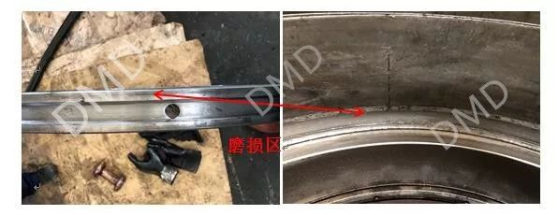
2. The end face and inner diameter of the intermediate spacer are partially worn
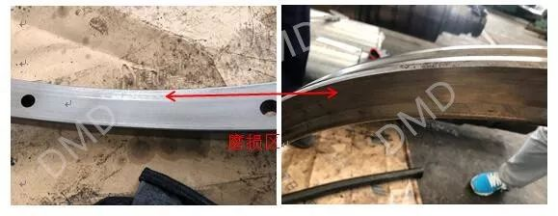
3. Deep spalling occurs at 90% of 4/1 of the end face of the middle spacer of row B of the rolling element
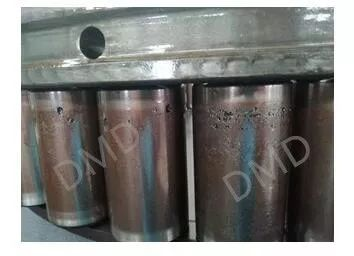
4. The outer diameter of the washer at the inner diameter of the intermediate spacer corresponding to row B of the cage is partially worn
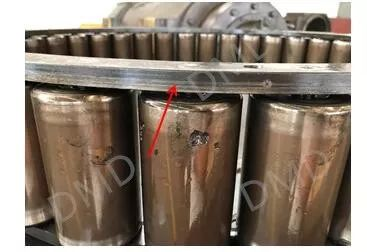
3、 Cause analysis
According to the above fault 1, the outer diameter of the intermediate spacer and the corresponding position of the bearing box are severely worn. It is judged that there is axial clearance after the bearing assembly is completed. When the bearing runs at high speed, the axial component is transmitted to the four row rolling elements through the bearing inner ring-1, inner ring-2, and the rolling elements are transmitted to the outer ring flange, side retaining ring-1, side retaining ring-2, and middle retaining ring of the bearing.
From the bearing structure analysis, it can be seen that when the axial force component acts, only the axial force component of rolling element B and rolling element C will act on outer ring a or outer ring B at the same time, which will cause the outer ring to move towards the opposite direction of the intermediate spacer, resulting in a gap between one end face of the intermediate spacer and the outer ring end face, and finally move in the circumferential direction with the rolling element, resulting in serious wear between the outer diameter and the inner diameter of the stationary bearing box.
According to the above faults 2 and 4, it is determined that the inner diameter of the cage and the intermediate spacer ring interferes with each other during the operation of the bearing, and then the dimension measurement is carried out to measure the clearance between the outer diameter of the cage and the inner diameter of the intermediate spacer ring after the installation of the bearing. The measurement data is: 5.2mm; Measure the clearance between the cage pin and the rolling element, and the measured data is: 2.0mm; Measure the difference between the outer diameter of the middle spacer and the outer diameter of the bearing. The measured data is: 0.9mm (the outer diameter of the outer spacer is smaller than the outer diameter of the outer ring); Measure the diameter difference between the bearing housing and the outer diameter of the bearing and the diameter difference of the spacer. The measured data is: 0.8mm (the diameter of the outer spacer is larger than that of the outer ring).
Through calculation and synthesis of the ellipse and deformation of the cage, under the action of centrifugal force during high-speed operation, the high point of the ellipse will rub and interfere with the inner diameter of the intermediate spacer. The interference and axial clearance lead to the irregular operation of the rolling element, and the inclination causes abnormal wear near the end face, and between the end face and the end face of the bearing outer ring and the spacer ring, which eventually leads to deep peeling.
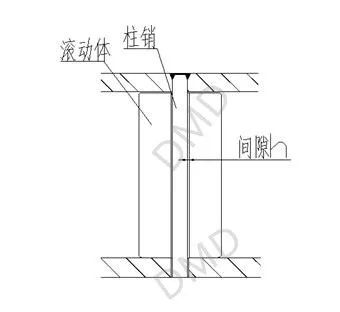
4、 Adjust direction
1. Reduce the difference between the outer diameter and the outer diameter of the intermediate spacer and control it within 0.1-0.15mm.
2. Increase the clearance between the outer diameter of the cage and the inner diameter of the intermediate spacer (according to the size of the mating space).
3. To ensure the installation quality of bearing, especially the control of axial clearance, it is recommended to be 0-0.05mm.